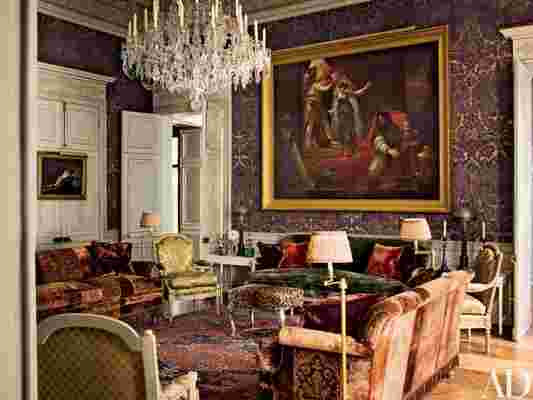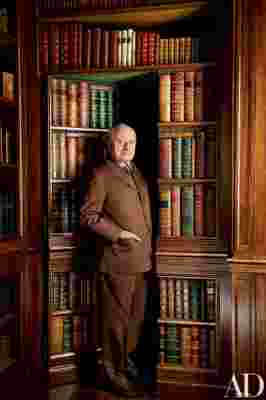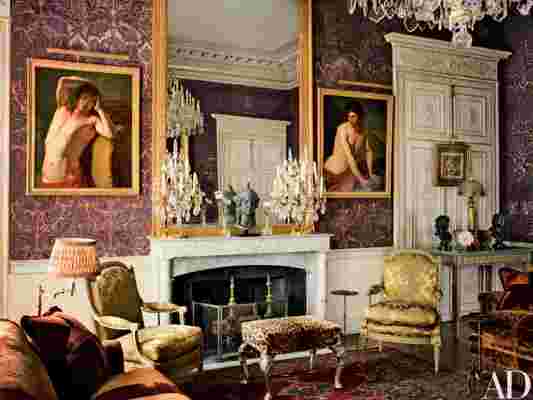March 05,2022
See How Pierre Bergé Transformed the Enchanting Top Floor of His Paris Apartment
by David Stewart
This article originally appeared in the May 2015 issue of Architectural Digest.
As first impressions go, Roberto Peregalli and Laura Sartori Rimini—the duo behind the Milan interiors firm Studio Peregalli —certainly left a strong one on Pierre Bergé. A few years ago the Parisian businessman and legendary fashion power broker was in Tangier, Morocco, where he maintains a residence, when garden-design guru Madison Cox invited him to meet the pair at Peregalli’s home there. Stepping inside the house, an atmospheric mix of old-world romance and Moroccan flourishes, Bergé was enchanted. “It was like hearing a Beethoven symphony,” he recalls. “I was in complete awe.” So much so that he instantly knew they’d be perfect for a special project. As he explains it, “I wanted them to make a work of art.”
Bergé—who built a global fashion empire with his late companion, Yves Saint Laurent—commissioned the designers to completely reimagine the upper level of his famously chic Paris duplex, set within an 18th-century building on the Left Bank. “I don’t really live in that part of my home,” confesses Bergé, who resides on the ground floor, in impeccable interiors that open to a luscious garden devised by Pascal Cribier and Louis Benech.
The upstairs space, acquired several years after Bergé bought the lower floor, had long been a work in progress: a suite of partially decorated rooms en enfilade where he displayed precious pieces of furniture and art. Bergé, of course, is one of the world’s great collectors. Even after the record-setting 2009 auction of treasures he and Saint Laurent had amassed (the sale tallied more than $480 million), Bergé still had many priceless works, among them paintings by the French Romantic master Théodore Géricault as well as hundreds of rare books and manuscripts. A shared love of literature, Bergé says, was part of what had attracted him to Peregalli, a philosophy scholar who has penned a volume on Marcel Proust. “It’s no surprise that the firm’s designs have Proustian undercurrents,” Bergé says. “Their work is all about regaining lost time.”



Sartori Rimini likens the project to an archaeological dig rather than an exercise in remodeling. “The goal was to preserve as much of the space as possible,” she says. “We wanted to see what was behind the layers that had accumulated over time.” One can hardly blame them for their curiosity. The building’s former residents include Édouard Manet, born there in 1832, and General Hubert Lyautey, a military governor of colonial Morocco who had lived in Bergé’s apartment in the early 20th century. “These rooms needed to reference their past as the home of a general, to be sober but grand,” says Sartori Rimini. Adds Peregalli, “Pierre wanted a space that represented, to him, the best of what it had the potential to become. I think it amused him to give us carte blanche.”
The designers made little in the way of invasive changes, a key exception being the addition of the petit salon’s barrel-vaulted ceiling, a fanciful canopy painted in a treillage motif. Rather, the bulk of the work focused on crafting evocative backdrops for Bergé’s collection—and for the gatherings he might host here. The pair recruited expert artisans to strip coats of paint off the moldings throughout, discovering traces of gilding that had been obscured with time. Those gold touches were re-created in the spaces but also dappled with simulated vagaries of wear, so as not to appear perfect. “What is most important to us is harmony,” explains Peregalli. “You should enter a room and not know if it is old or new. It makes the project believable.”
In another sleight of hand, the designers covered the main salon’s walls with canvas painted in a trompe l’oeil that mimics the look of silk damask gleaming in shifting light. For the dining room, the duo centered their scheme on a quartet of neoclassical works by Jean-Baptiste Debret depicting the four seasons. They surrounded the magnificent pieces with wood-and-mirror wall panels trimmed with hand-painted paper borders set under glass. And in the library, existing bookshelves were faux-finished to look like mahogany and accented by gilded trim.
With new fringed linen curtains and Bergé’s antiques thoughtfully arranged, the rooms now offer a blend of French and Italian styles with a hint of Russia. “There is something Chekhovian in them,” Peregalli notes. “It’s French taste as interpreted by foreigners, that’s for sure.”
For his part, Bergé couldn’t be more thrilled with the results. “Roberto and Laura are more than decorators—they’re artists,” he reflects. And much of his love for the space, he says, comes from knowing that he has written his own chapter for a building already brimming with history. “One day, no doubt, this will all vanish just as quickly as it arrived,” he says. “In the meantime, it’s mine.”






